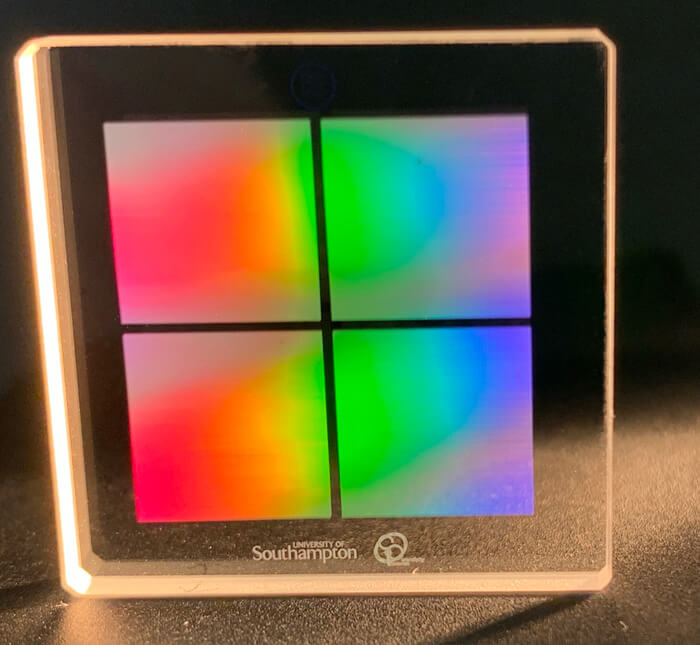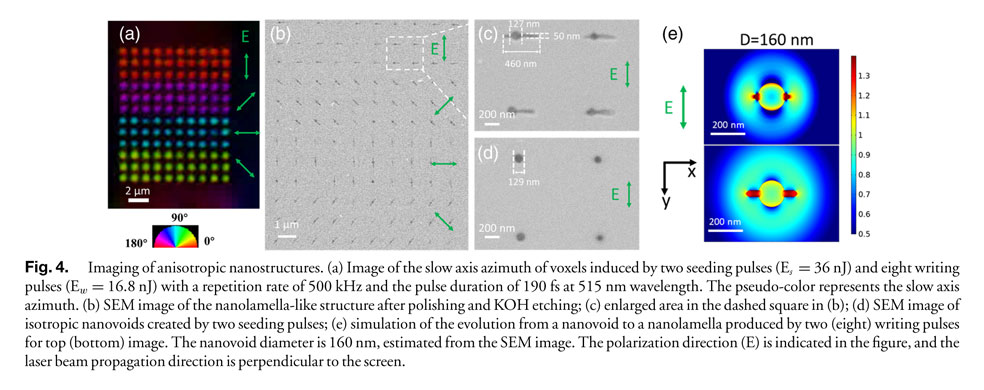
4th November 2021 High-speed laser could write 500 TB of data into glass A breakthrough by UK researchers could make ultra-high density, 5D optical storage practical for long-term data archiving.
Researchers have developed a fast and energy-efficient laser-writing method for producing high-density nanostructures in silica glass. These tiny structures can be used for long-term five-dimensional (5D) optical data storage, more than 10,000 times denser than Blu-Ray optical disc storage technology. "Individuals and organisations are generating ever-larger datasets – creating the desperate need for more efficient forms of data storage with a higher capacity, lower energy consumption and longer lifetime," said doctoral researcher Yuhao Lei from the University of Southampton in the UK. "While cloud-based systems are designed more for temporary data, we believe that 5D data storage in glass could be useful for longer-term data storage for national archives, museums, libraries or private organisations." Writing in the journal Optica, Lei and his team describe their new method for writing data that encompasses two optical dimensions and three spatial dimensions – hence, "5D". The new approach can write at speeds of 1,000,000 voxels per second, which is equivalent to recording about 230 kilobytes of data (more than 100 pages of text) per second. 5D optical data storage in transparent materials has been demonstrated before. Researchers first proposed the concept of optical memory based on femtosecond laser writing to transparent material in 1996. Then in 2013, the University of Southampton demonstrated the recording and retrieval of a single 300 kb text file, etched into glass with potential for 360 TB of capacity. The same university in 2016 demonstrated the recording of major historical documents such as the Universal Declaration of Human Rights, the Magna Carta, and King James Bible. However, writing data fast enough and with high enough density for real-world applications has proved challenging. For their latest breakthrough, researchers at the university used a femtosecond laser with a high repetition rate to create tiny pits containing a single "nano-lamella"-like structure measuring just 500 by 50 nanometres each. Rather than using the femtosecond laser to write directly in the glass, they harnessed the light to produce an optical phenomenon known as near-field enhancement, in which the nanostructures are created by a few weak light pulses. This minimised the thermal damage that has been problematic for other approaches that use high-repetition-rate lasers. "This new approach improves the data writing speed to a practical level, so we can write tens of gigabytes of data in a reasonable time," said Lei. "The highly localised, precision nanostructures enable a higher data capacity because more voxels can be written in a unit volume. In addition, using pulsed light reduces the energy needed for writing."
The researchers used their new method to write 5 gigabytes of text data onto a silica glass disc about the size of a conventional compact disc with nearly 100% readout accuracy. Each voxel contains four bits of information, and every two voxels correspond to a text character. With the increased writing density available from their method, the disc would be able to hold 500 terabytes (TB) of data – an improvement on the earlier 360 TB capacity, and 10,000 times greater than a dual-layer Blu-ray disc. Lei and his colleagues are now working to increase the writing speed further and to make the technology usable outside the laboratory. With upgrades to allow parallel writing, the researchers say it should be feasible to write 500 TB of data in about 60 days. A possible near-term application might be the archiving of DNA records, according to study co-author, Peter Kazansky. The physical mechanism is generic, according to Lei, meaning it could also be used for fast nanostructuring in transparent materials for applications in 3D integrated optics and microfluidics. In addition to its vast capacity, this storage method has further advantages. It has high thermal stability of up to 1,000°C and its lifetime is billions of years – meaning our distant descendants could retain use of an original disc even after the Earth has been destroyed.
Comments »
If you enjoyed this article, please consider sharing it:
|









